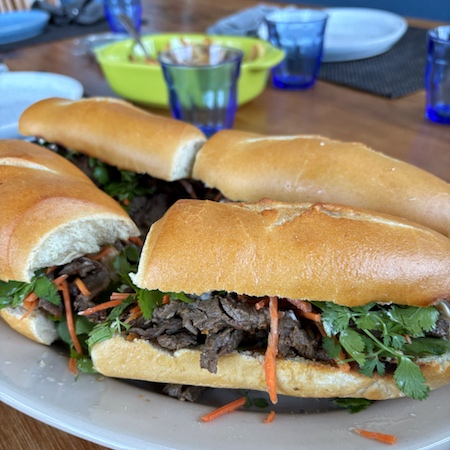Chef Miki’s Tips for making Pan-Seared Pepper-Crusted Pork Tenderloin
THYME AND DRIED HERBS – Fresh herbs always provide the best results, but having dried herbs in your pantry never hurts. Dried herbs work best for long-term cooking-stews, spaghetti sauces, etc as the oils slowly release into the recipe. If you plan to freeze your dish, refresh the thawed dish with fresh herbs and a dash of citrus or vinegar to brighten flavors. If using dried, use HALF AS MUCH AS FRESH. Store dried herbs away from heat and no longer than 4-6 months as heat will release the natural oils that yield the uniqueness of each herb. Always crush your dry herbs to begin releasing the essential oils before including in a recipe. After handling herbs, wash your hands well to prevent any of the oils from irritating skin or eyes. For fresh herb cleaning and storage, please refer to Melissa’s cooking tip:
Thyme (as well as rosemary) can be added whole, on the stem, to many dishes as the leaves will fall away as the herb cooks, then remove the remaining stems. If you’d prefer, remove the leaves by holding the washed sprigs by the tips in one hand, and, using your other thumb and forefinger, strip the leaves from top to bottom, lightly pinching the sprig as you travel down the stem. This method also works with tarragon, rosemary, and other small-leaf herbs.
MINCING THYME LEAVES – After the sprigs have been washed and patted dry, place them on a dry, clean cutting board. Any moisture will make mincing difficult as it causes the leaves to stick. Have a sharp chef knife or santoku-style knife ready. Carefully hold the bunch of sprigs together in your fist, curling your fingers under to avoid the knife blade. Slice through the bunch, slowly moving your bunched fingers in a crawling motion to expose more of the sprigs. this method works well with any ‘bunch’ of herbs or aromatics-parsley, dill weed, chervil, thyme, etc.
KOSHER SALT – Many of us are watching our salt intake. Salt, however, is used to bring out the flavor of ingredients and dishes. In an earlier challenge I neglected to mention to you the use of Kosher salt in place of iodized. Iodized salt is just that-iodine added, leaving a metallic flavor to your dish. Kosher salt is natural and not adulterated. Use Kosher salt in the same quantity, but crush it slightly between your fingers while adding to dissolve quicker. I keep a little bowl that holds about two tablespoons next to my stove for seasoning while cooking, and store the big box in the pantry. The large salt grains used as a paste are also good for cleaning tea and coffee stains off of ceramic without scratching. (Thanks, Mom!) Also, make a paste with oil and salt to clean and season cast iron.
DARK BROWN SUGAR – use this in place of light brown, which isn’t as sweet. Dark brown sugar is also used in baking to yield a crisper crust on baked goods, or give a little more softness to a cookie. When measuring brown sugar, always pack down the sugar to get a correct amount. Store brown sugar in an airtight container. If your brown sugar becomes hard, you can place it in the microwave and heat it on low a minute at a time until you can break off the amount you need. You’ll need to return the unused portion to an air-tight container.
VEAL STOCK – There’s nothing like home made veal stock, but since we all don’t have room for 50 pounds of bones to make stock, nor the pot to make it, you can find in specialty grocery stores and gourmet shops ready made veal stock. Beef stock can be used, but the flavor is not quite the same. For this recipe’s 1/4 cup, prepared, we’ll be okay. Or, use the prepared amount of the bouillon we discussed in an earlier episode.
It may be strong flavored, so cut it with a small amount of liquid before adding it to the recipe. If you really have some spare change, you may invest in a small package of veal glace. It is a concentrate that can be found in the meat department or sometimes the frozen food section in a small jar or cube form. Just follow the directions to make your required amount. If you really like pan sauces as this recipe instructs, you may want to consider the investment.
BUTTER – As Use unsalted butter. However, for the pan sauce, the butter must be COLD! Measure the amount needed, then cut into small 1/4″ cubes and chill. Margarine will not yield the same creamy results, and sauce is one time you really don’t want to skimp. You’ll be making an emulsion where the fat and the acid suspend together-just like salad dressing. If the fat is too thin too quickly, it will break the sauce and you’ll have oil pools.
WINE – Please see our tip, “wine, cooking with”. Without mentioning brand names, try a good, middle of the road wine that you wouldn’t mind drinking while you cook or have for one of those rough days. Don’t be foolish and purchase really good wine for cooking. One bottle of wine yields about 3 1/2 glasses of wine, or two glasses if it’s a rough day! If drinking the wine, allow it to ‘breathe’ about 30 minutes before consuming to enjoy the full bouquet.


